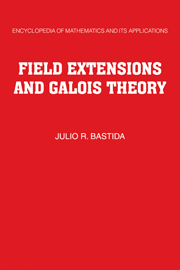Book contents
- Frontmatter
- Contents
- Editor's Statement
- Section Editor's Foreword
- Preface
- Historical Introduction
- Prerequisites
- Notation
- Field Extensions and Galois Theory
- Chapter 1 Preliminaries on Fields and Polynomials
- Chapter 2 Algebraic Extensions
- Chapter 3 Galois Theory
- Chapter 4 Transcendental Extensions
- References and Selected Bibliography
- Index
Chapter 4 - Transcendental Extensions
Published online by Cambridge University Press: 05 June 2013
- Frontmatter
- Contents
- Editor's Statement
- Section Editor's Foreword
- Preface
- Historical Introduction
- Prerequisites
- Notation
- Field Extensions and Galois Theory
- Chapter 1 Preliminaries on Fields and Polynomials
- Chapter 2 Algebraic Extensions
- Chapter 3 Galois Theory
- Chapter 4 Transcendental Extensions
- References and Selected Bibliography
- Index
Summary
DIMENSIONAL OPERATORS
This section is set-theoretical in its entirety. Our objective is to present an axiomatic treatment of dimension theory, essentially due to Steinitz, that can be suitably applied in a number of situations. To the reader familiar with the dimension theory for vector spaces, it will become apparent that here we are merely selecting some simple facts on vector spaces as axioms, and then deriving their consequences formally.
It should be mentioned, incidentally, that the dimension theory for vector spaces is itself one of the instances covered by the axiomatic theory discussed here.
Let E be a set. Recall that the symbol denotes the power set of E, that is, the set consisting of all subsets of E. By a dimensional operator onE we understand a mapping d from to having the following properties:
(i) If S ⊆ E, then S ⊆ d(S).
(ii) If S ⊆ E, then d(S) = d(d(S)).
(iii) If S ⊆ T ⊆ E, then d(S) ⊆ d(T).
(iv) If S ⊆ E, and if Ω denotes the set of all finite subsets of S, then d(S) = ⋃A ∈ Ωd(A).
(v) If S ⊆ E, x ∈ E, and y ∈ (S ⋃ {x}) − d(S), then x ∈ d(S⋃{y}).
The last property in the preceding definition is known as the exchange axiom.
- Type
- Chapter
- Information
- Field Extensions and Galois Theory , pp. 212 - 280Publisher: Cambridge University PressPrint publication year: 1984



